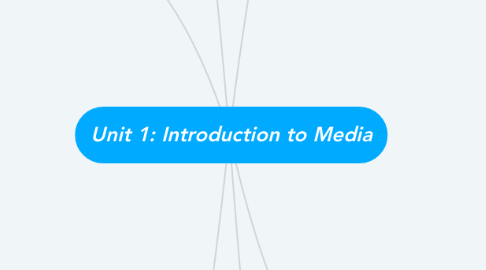
1. Lesson 1: What is Media?
1.1. Defining Media
1.1.1. Media are the communication outlets or tools used to store and deliver information or data.
1.2. Communication Media
1.2.1. To show us how humans relay messages to each other.
1.3. Feedback Mechanism
1.3.1. A very important factor was considered: a feedback.
1.4. Media as an Information Industry
1.4.1. Technology related information conduits such a radio and television encompass what media is.
1.5. Media as a Culture of Entertainment
1.5.1. It may be more concerned with using or accessing media for its entertainment value.
1.6. Kinds of Media
1.6.1. Traditional Media
1.6.2. New Media
1.6.3. Socila Media
1.6.4. Mobile Communication Technology
1.6.5. Related and Emerging Technologies
2. Lesson 2: Media Then and Now
2.1. Brief History of Media
2.1.1. Communicating with each other is one of the most essential and immediate need that they had to learn,develop and master.
2.1.2. Pre-industrial Age
2.1.2.1. Industrial Age
2.1.2.1.1. Electronic Age
2.2. Brief History of Philippine Media
2.2.1. Pre-colonial Traces
2.2.2. The print Industry and Filipino Freedom
2.2.3. The European Film Import
2.2.4. The Broadcast Industry
2.2.5. Local Online Media
2.3. The state of Media Today
2.3.1. From Globalization to Glocalization
2.3.2. The Local Landscape
2.3.3. Media Ownership
2.3.4. Mainstream Media
2.3.5. Alternative and Independent Media
2.3.6. Community Media
2.3.7. State-owned Media
3. Lesson 3: Understanding Media: Aesthetics of the Image,Text, and Audio
3.1. Framing and Reading
3.1.1. Framing means Construcrt,compose or image something, meaning to create with solid plan.
3.2. Newspapers and Journalism
3.2.1. Books, Comics, Magazines, and the Publishing Industry
3.2.1.1. Photography and Timeless Image Concepts
3.3. Farming and Listening
3.3.1. Radio and Evoking Imagination
4. Lesson 4: Understanding Media: Aesthetics of Film and TV
4.1. The film form
4.1.1. Modes of Film Production
4.1.2. Film Formats
4.1.3. Film Image Composition
4.1.4. Motion Framing Concepts
4.2. The Tv Broadcast
4.2.1. Kinds of TV Show
4.2.2. TV Show Anatomy and Advertising
4.3. Crafting Media Messages
4.3.1. Creating Meaning in Audio Production
4.3.2. Creating Meaning in Image Production
4.3.3. Creating Meaning in Audiovisual Production
5. Lesson 5: Understanding Media: Aesthetic of New Media
5.1. Deconstructing New Media
5.1.1. The term of new media encompasses the computer-originated and usually Internet-delivered forms of information and communication technology.
5.2. New Media Technology: Convergence and Characteristics
5.2.1. New Media as Multimedia
5.2.2. New Media Transitions: from Synergy to Transmedia
5.3. Intersecting Traditions Media and New Media
5.3.1. Journalism + Internent = Blogging
5.3.2. Broadcasting + Internet = Podcast
5.3.3. Film + Internet = YouTube
5.4. Transitioning Media, Transitioning Users
5.4.1. Media have two types of audiences living in the digital age : The Dugutal Native and The Digital Immigrant
6. Lesson 6: Understanding Media: Aesthetics of Social Networking
6.1. Deeper Understanding of Social Media
6.1.1. An offshoot of new media is social media. It needs a closer look for the huge role it has been playing and continuing to be played.
6.2. What is Social Networking?
6.2.1. A supportive system of sharing information and services among individuals and groups having a common interest.
6.3. Kinds of Social Media and Its Varying Uses
6.3.1. Print-based
6.3.2. Audio-based
6.3.3. Photo-based
6.3.4. Video-based
6.3.5. Social Networking Sites
6.4. Relevance of Social Media in Today's Society
6.4.1. Personal Communications
6.4.2. Business and Customer Care Tools
6.4.3. Social Services and Governance
6.4.4. Educational Tools
6.4.5. Advocacy Campaigns for Social
6.5. Traditional Media Coverage and Social Media Enhancement
6.5.1. Messages are being reworked thanks to immediate and elaborate feedback coursed through social medua channels
6.6. Entertainment Portals
6.6.1. Perhaps the most enjoyable use of social media for everyone is pop culture content curating.

